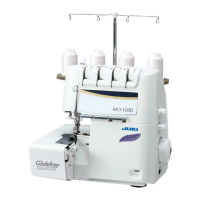
Do you have a question about the JUKI MO-1000 Series and is the answer not in the manual?
| Type | Overlock Sewing Machine |
|---|---|
| Air Threading System | Yes |
| Differential Feed | Yes |
| Differential Feed Ratio | 0.7 - 2.0 |
| Adjustable Stitch Length | Yes |
| Adjustable Cutting Width | Yes |
| Built-in Rolled Hemming | Yes |
| LED Light | Yes |
| Needle Count | 1 or 2 |
| Needle Type | 130/705H |
| Thread Tension | Manual |
| Motor | AC Motor |
| Maximum Sewing Speed | 1500 stitches per minute |
| Stitch Length | 1 to 4 mm |
| Presser Foot Lift | 5 - 8 mm |
| Number of Threads | 2/3/4 threads |
Identifies the specific sewing machine model and its series designation.
Details the available stitch types and thread configurations supported by the machine.
Specifies the maximum sewing speed and its rated operational performance.
Indicates the standard needle gauge recommended for optimal machine operation.
Lists the various overedge stitch widths applicable to different thread setups.
Illustrates and labels the external parts and features of the sewing machine.
Details the internal components and mechanisms of the sewing machine.
Procedure for setting the correct vertical height of the needle bar.
Guidelines for adjusting the feed dog's horizontal and vertical positioning.
Process for adjusting the loop lift mechanism to ensure proper stitch formation.
Steps to synchronize the movement and timing of the upper and lower loopers.
Method for setting thread tensions on the controller for optimal stitch quality.
Procedure for ensuring proper meshing and alignment of the upper and lower knives.
Steps to set the correct operational timing for the upper knife.
Instructions for applying oil to specific moving parts of the sewing machine.
Guidance on the recommended types of grease and their application points.
Maintenance and cleaning procedures for the looper threader mechanism.
Common causes and solutions for instances of needle thread breakage during sewing.
Troubleshooting steps for identifying and resolving causes of needle breakage.
Diagnosing and fixing issues related to skipped needle stitches.
Addressing problems associated with improper chain stitch formation.
Solutions for inconsistent or uneven fabric feeding during the sewing process.
Identifying the causes and implementing remedies for material puckering.